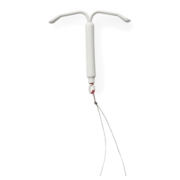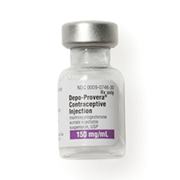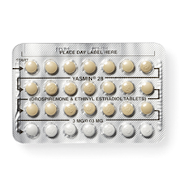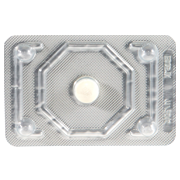What's in a birth control label?
The good, the bad, and the fine print.

Any prescription birth control method you buy in the United States comes with a square of delicately thin paper, folded until it won’t fold any more, covered in teeny-tiny print. It’s called a “package insert” or a “label”—and it may be telling you lies.
First, some history…
It wasn’t so long ago that there was no such thing as a drug label. In the 1950s, people used prescription drugs after merely talking with their doctors. Faith in medicine was high, thanks to new and amazing drugs like antibiotics. In general, there were fewer drugs, and fewer people had ailments that required years of continuous medication. New drugs were approved by the U.S. Food and Drug Administration (FDA) after manufacturers proved they were safe; there was no formal requirement to prove they worked.
In 1957, the birth control pill came to the U.S. The FDA first approved it to treat “menstrual disorders”—which tens of thousands of women suddenly developed. When the maker of the pill applied to the FDA to allow women to use it as a contraceptive, the FDA dragged its feet. In 1960, the FDA finally approved the pill for contraception, but only for two years of use. It was the first modern birth control method and the first hormonal medication taken by healthy people. Around the same time, Congress required makers of drugs to prove to the FDA not only that a drug is safe, but that it works as advertised.
Over the decade that followed approval of the birth control pill, hundreds of thousands of U.S. women started using it. Early versions of the pill had much higher doses of hormones in them, and some women had serious side effects as a result. Reports of problems with the pill always made sexy headlines (still do). Eventually, in 1970, the controversy about the safety of the pill got so heated that Congress called for a hearing about it. Women’s health activists attending the mostly-male hearing (sound familiar?) demanded that the risks of the pill be spelled out for any potential user to read in black and white. They argued that women using the pill in the last decade hadn’t been adequately warned of the potential side effects. So the label was invented for the pill, and now all prescription drugs are required to carry one.
Why so dense?
Labels are designed mainly for doctors to stay in the know about the medicines they prescribe, so they have always used intense doctor-speak. In the 1980s, labels got even more complicated, partly because lawyers started using them as evidence in cases against drug manufacturers. To protect themselves from lawsuits, drug makers added all kinds of hypothetical risks and problems to labels—even when there was little proof that the medicine actually caused the problem. In an effort to simplify, the FDA came up with a new label format. All medicines approved after 2001 are required to include highlights and a table of contents on their label. The FDA also helpfully required that all labels be printed in at least 6 point font.
Black box warnings
Sometimes a label has a box right at the top, outlined in black, like this one. It’s called a “black box warning,” and it is there to draw attention to an especially serious side effect or potential reaction to a medication. All black box warnings on birth control describe risks that came to light after the methods were approved—the FDA uses the black box to make sure everybody knows about it. Learning about some risks of a medicine many years later is not unusual, since to learn about very rare risks, millions of people have to use it. Methods with black box warnings include the shot, the patch, and some pills containing the progestin drospirenone (like Yaz, Yasmin, Beyaz, Safyral, and their generic versions).
Did you say something about lies?
We don’t mean to suggest that the labels are designed to mislead—but they’re not necessarily totally accurate, either. The FDA’s job is to make sure that the medicines used in the U.S. are safe and effective, and that the people who make medicines use truthful advertising. It has never been their job to keep up with all the latest research on how a medicine can be used—that’s the responsibility of health care providers. The FDA knows that doctors and nurses sometimes recommend using drugs in ways that are not listed on the label, and they have no problem with that. For example, birth control pills are approved for contraception, but doctors sometimes recommend them to treat acne or make periods more manageable. There’s research to back up the use of certain hormonal methods for those things, too. So why isn’t all that on the label?
To add a new use for an approved contraceptive to its label requires big scientific studies involving thousands of women, years of work, and tens of millions of dollars. Sometimes the companies that make contraception just don’t think it’s worth the trouble. So labels that are just a few years old can be out-of-date, which can be really confusing if you’re reading one on your own.
These are a few lies labels tell, and the truths we now know thanks to rigorous research.
Lie: A woman can’t use the Mirena IUD unless she’s had at least one child.
Truth: Women can use any IUD regardless of maternal-status.
Lie: Women with high blood pressure shouldn’t use the implant or the shot.
Truth: The estrogen hormone in the pill, the patch, and the ring is associated with increased risk of heart attack or stroke when women have high blood pressure to begin with. The implant and the shot contain no estrogen, and there’s no evidence that their ingredients (progestins) cause these problems.
Lie: Antibiotics will make the pill less effective.
Truth: The only antibiotic that makes the pill less effective is called Rifampin, or Rifampicin. It’s used very rarely for only the toughest cases of tuberculosis and methicillin-resistant Staphylococcus aureus (MRSA) infections. No other antibiotics change the effectiveness of the pill.
Lie: Using the shot for too long weakens your bones.
Truth: There is no evidence linking the shot to broken bones. The World Health Organization and the U.S. Centers for Disease Control have reviewed all the evidence about this question, and they agree it’s safe for women to use the shot for as long as they like.
Sooo…should I care what the label says?
Yes and no: labels can sometimes contain important information, but they can also be totally out-of-date. The first time you use a new prescription birth control method, your health care provider should go over the information on the label with you. Some clinics have created their own forms that show the information on the label in a font size you can actually read. Either way, it’s their job to translate any jargon into plain English and answer all your questions. If you have a specific medical condition, ask your provider to go over relevant information under the heading “Contraindications.” If you are taking any other medication, including herbal supplements, ask your provider to go over the “Drug Interactions” section.
The bottom line? Labels can be helpful sources of information, but they’re not usually reader-friendly. And if you’re looking for the most up-to-date information, they’re not so hot. If you want the latest evidence-based information about birth control, the U.S. Medical Eligibility Criteria for Contraceptive Use is up-to-date, but sometimes jargony. This chart provides a good jargon-free summary. We’ve said it before, and we’ll say it again: your nurse or doctor is the best source for more information!
Bedsider’s guide to birth control warning labels
Wondering where your birth control stands in terms of safety warnings? Here are links to the nitty gritty details about some of the most common methods. Sadly, some of these labels were created before the FDA designed its new label, so they don’t offer highlights or a table of contents. We’ve marked them “old-style” so you know what you’re getting into…
Front and center
These options have a black box warning before any other information on the label.
Depo-provera: The shot carries a black box warning on loss of bone mineral density. However, recent studies show the bone loss is reversible, so the warning is actually out of date now.
Xulane and Ortho Evra: The patch carries an old-style black box warning about smoking, venous thromboembolism risks, and the serum spike of ethinyl estradiol that occurs when the patch is first applied.
Yaz: This combined pill carries a black box warning about on smoking, as well as new warnings about drospirenone and venous thromboembolism risks. Check out our black box section above for info on other pills containing drospirenone.
The warning can wait
These options carry a warning, but it doesn’t appear till the “WARNINGS” section of the label.
NuvaRing: The ring has an old-style label with a boxed warning about smoking.
Ortho tri-cyclen combined pill: This old-style label, similar to the labels of combined hormonal pills with older progestins, carries a boxed warning about smoking.
Nothing to see here
These options don’t carry any special warnings.
The Mirena IUD
The Paragard IUD (Old-style)
Nexplanon (the next generation of the implant)
Plan B One-step emergency contraception
Micronor mini-pill (Old-style)
We’re all about keeping you informed about any potential health risks you could face with your birth control method, but it’s also important to remember that the risks for the riskiest methods are still really small, especially compared to the risks that come with pregnancy. If you feel good on the method you’re using, your best option may be to stick with what’s working. That said, if you’re concerned about the potential risks of your method, you should talk to your health care provider about it.
How do you feel about this article?

Heat up your weekends with our best sex tips and so much more.




